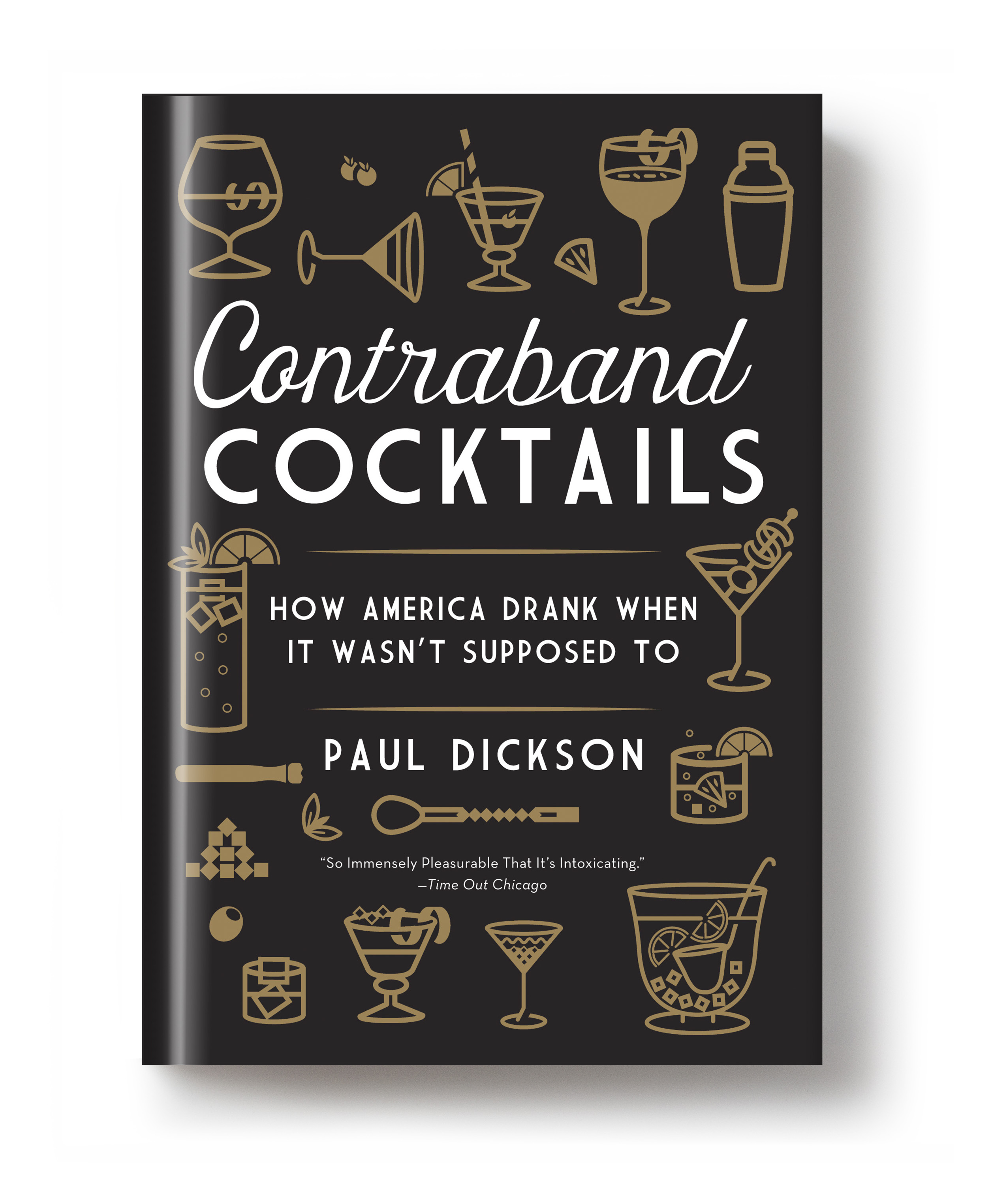Featured Cocktail
- 1 lime
- 1 glass of gin
- Soda or seltzer water
Preparation: Place a piece of ice in a tumbler. Cut a fresh lime in half and squeeze the juice in the glass. Add one glass of gin and fill balance with seltzer or soda water.
“A national treasure who deserves a wide audience.” —Library Journal
Americans weren’t supposed to drink at all during Prohibition, but that’s not how things worked out: just as Congress amended the Constitution to keep their countrymen dry (while a bootlegger known as The Man in the Green Hat helped keep wet bars well-stocked on Capitol Hill), “cocktail culture” as we know it was born. The Bloody Mary, sleek chrome cocktail shakers, hip flasks and streamlined bar carts, craft mixology, and hundreds of other essentials of modern drinking life owe their origins to the dark days and boozy nights of the Dry Years. Rich with history, political intrigue, and cultural curiosities, in Contraband Cocktails Paul Dickson pours us an intoxicating narrative of how Americans drank during Prohibition.
But Contraband Cocktails isn’t just a wild ride with bootleggers and bartenders, rumrunners and mobsters, it also brims with literary lore: from when the word “cocktail” first appeared in print in D. H. Lawrence’s Lady Chatterly’s Lover, to Daisy pouring Tom a mint julep at the Plaza Hotel in The Great Gatsby, to recipes (some of them shockingly, comically undrinkable!) for what Ernest Hemingway, Dorothy Parker, Tennessee Williams, and many others were drinking when they ordered “just the usual,” this small, heavily annotated mixology brings readers out of our 21st century take on the speakeasy and straight into a chair at the Algonquin Roundtable.
We also visit the dimly lit nightclubs that displaced legal cabarets and gave a backdrop to the Jazz Age, a hedge outside the White House where bootleggers stashed bottles of booze in a burlap bag, and even the bathtub where the great chef and food writer James Beard spent Sunday afternoons concocting homemade gin.
Chock-full of scandalous history, delicious anecdotes, dozens of recipes, and a glossary of terms that could surprise even the most seasoned bartender, Paul Dickson’s Contraband Cocktails is the perfect companion to any reader’s Cocktail Hour.
Praise
One of the great ironies of 20th-century history is that the best cocktails were developed during Prohibition. Hell, there was probably never a better time to be a drinker! Part recipe guide, part history lesson, Dickson’s book is best read with a Manhattan.
Dickson loads every page with facts, anecdotes and telling details about life under Prohibition. As we close out 2015, let me then toast [this] excellent book...
"Contraband Cocktails is a neat book as carefully crafted as some of the best cocktails are: without a word out of place and a concise history that is as much entertaining as it is educating. … Contraband Cocktails is a fabulous work that ought to be in any hipster’s library or on the reading list of faux-speakeasy bartenders, but otherwise absolutely anyone with a fascination for the 1920s, who loves The Great Gatsby (films or book), or who are interested in the history of alcohol will definitely need to read this."
Paul Dickson’s rollicking history of how Prohibition had the unintended consequence of killing off the saloon of the previous century and giving rise to first, the speakeasy, and then the cocktail bar … Mr. Dickson writes with verve on the true birthplace of the cocktail and the speakeasy where Prohibition was flouted most spectacularly — New York City. Gaudy Gotham’s clandestine drinking gave birth to the madcap cultural mix of jazz, fads in dance and slang, glamour status for bootleggers and organized crime.
Dickson’s latest, Contraband Cocktails: How America Drank When It Wasn’t Supposed To, began as a fascination with Prohibition-era recipe books that along the way naturally snowballed into an engaging discourse on classic cocktails replete with trivia, recipes, a list of -alcohol-related slang of the period and a fair amount of Golden-Era literary and celebrity gossip.
Paul Dickson, whose book Contraband Cocktails was recently published, says that [speakeasy] parties are an outgrowth of the popular speakeasy-style cocktail bars that evoke the Prohibition era. “We are still fascinated with the culture of the time — the Algonquin Round Table, Dashiell Hammett’s ‘Thin Man,’ the boozy escapades of W. C. Fields and so much more,” he said in an email. “‘The Great Gatsby’ is, after all, a novel about a bootlegger.”
Prohibition did have, however, at least a couple of positive effects, as Paul Dickson explains in Contraband Cocktails: How America Drank When It Wasn’t Supposed to (Melville House Publishing, 2015). The Temperance and Suffragette movements long had been intricately linked and the 18th and 19th Amendments both went into effect in 1920. But Prohibition itself also helped to obliterate old sexist boundaries. …Women danced, drank and smoked with men. They also went into the drinks businesses. Belle Livingstone ran the 58th Street Country Club, an illicit Manhattan joint that served bubbly and had a miniature golf course.Marie Waite (AKA Spanish Marie) was a pistol-toting rumrunner who moved booze from Havana to thirsty customers in Florida.
***
The Contraband Cocktails Website does not replicate the narrative of the book but does explore the era through original documents, photographs and discusses the great cocktails of the era with period recipes. Our advice: if you enjoy this website, you will love the book.

 Wash Post (12/31/15)
Wash Post (12/31/15)